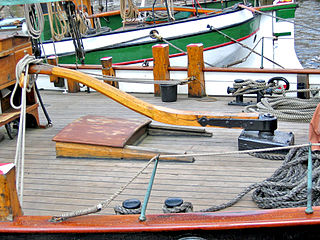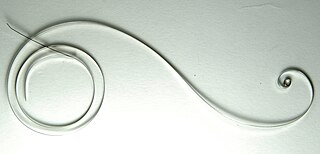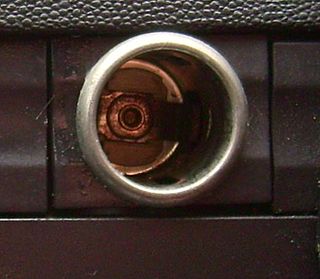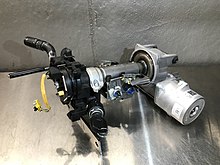
A tractor is an engineering vehicle specifically designed to deliver a high tractive effort at slow speeds, for the purposes of hauling a trailer or machinery such as that used in agriculture, mining or construction. Most commonly, the term is used to describe a farm vehicle that provides the power and traction to mechanize agricultural tasks, especially tillage, and now many more. Agricultural implements may be towed behind or mounted on the tractor, and the tractor may also provide a source of power if the implement is mechanised.

A differential is a gear train with three drive shafts that has the property that the rotational speed of one shaft is the average of the speeds of the others. A common use of differentials is in motor vehicles, to allow the wheels at each end of a drive axle to rotate at different speeds while cornering. Other uses include clocks and analog computers.

A strut is a structural component commonly found in engineering, aeronautics, architecture and anatomy. Struts generally work by resisting longitudinal compression, but they may also serve in tension.

A speedometer or speed meter is a gauge that measures and displays the instantaneous speed of a vehicle. Now universally fitted to motor vehicles, they started to be available as options in the early 20th century, and as standard equipment from about 1910 onwards. Other vehicles may use devices analogous to the speedometer with different means of sensing speed, eg. boats use a pit log, while aircraft use an airspeed indicator.

A tiller or till is a lever used to steer a vehicle. The mechanism is primarily used in watercraft, where it is attached to an outboard motor, rudder post or stock to provide leverage in the form of torque for the helmsman to turn the rudder. A tiller may also be used in vehicles outside of water, and was seen in early automobiles.

A steering wheel is a type of steering control in vehicles.

Automobile accessory power can be transferred by several different means. However, it is always ultimately derived from the automobile's internal combustion engine, battery, or other "prime mover" source of energy. The advent of high-powered batteries in hybrid and all-electrical vehicles is shifting the balance of technologies even further in the direction of electrically powered accessories.

A mainspring is a spiral torsion spring of metal ribbon—commonly spring steel—used as a power source in mechanical watches, some clocks, and other clockwork mechanisms. Winding the timepiece, by turning a knob or key, stores energy in the mainspring by twisting the spiral tighter. The force of the mainspring then turns the clock's wheels as it unwinds, until the next winding is needed. The adjectives wind-up and spring-powered refer to mechanisms powered by mainsprings, which also include kitchen timers, metronomes, music boxes, wind-up toys and clockwork radios.

Drive by wire or DbW technology in the automotive industry is the use of electronic or electro-mechanical systems in place of mechanical linkages that control driving functions. The concept is similar to fly-by-wire in the aviation industry. Drive-by-wire may refer to just the propulsion of the vehicle through electronic throttle control, or it may refer to electronic control over propulsion as well as steering and braking, which separately are known as steer by wire and brake by wire, along with electronic control over other vehicle driving functions.
Power steering is a system for reducing a driver's effort to turn a steering wheel of a motor vehicle, by using a power source to assist steering.

A drive wheel is a wheel of a motor vehicle that transmits force, transforming torque into tractive force from the tires to the road, causing the vehicle to move. The powertrain delivers enough torque to the wheel to overcome stationary forces, resulting in the vehicle moving forwards or backwards.
Steering ratio refers to the ratio between the turn of the steering wheel or handlebars and the turn of the wheels.
In mechanical horology, a remontoire is a small secondary source of power, a weight or spring, which runs the timekeeping mechanism and is itself periodically rewound by the timepiece's main power source, such as a mainspring. It was used in a few precision clocks and watches to place the source of power closer to the escapement, thereby increasing the accuracy by evening out variations in drive force caused by unevenness of the friction in the geartrain. In spring-driven precision clocks, a gravity remontoire is sometimes used to replace the uneven force delivered by the mainspring running down by the more constant force of gravity acting on a weight. In turret clocks, it serves to separate the large forces needed to drive the hands from the modest forces needed to drive the escapement which keeps the pendulum swinging. A remontoire should not be confused with a maintaining power spring, which is used only to keep the timepiece going while it is being wound.

An automobile auxiliary power outlet in an automobile was initially designed to power an electrically heated cigarette lighter, but became a de facto standard DC connector to supply electrical power for portable accessories used in or near an automobile directly from the vehicle's electrical system. Such include mobile phone chargers, cooling fans, portable fridges, electric air pumps, and power inverters.
A motor vehicle service or tune-up is a series of maintenance procedures carried out at a set time interval or after the vehicle has traveled a certain distance. The service intervals are specified by the vehicle manufacturer in a service schedule and some modern cars display the due date for the next service electronically on the instrument panel. A tune-up should not be confused with engine tuning, which is the modifying of an engine to perform better than the original specification, rather than using maintenance to keep the engine running as it should.

The Daimler Reitwagen or Einspur was a motor vehicle made by Gottlieb Daimler and Wilhelm Maybach in 1885. It is widely recognized as the first motorcycle. Daimler is often called "the father of the motorcycle" for this invention. Even when the steam powered two-wheelers that preceded the Reitwagen, the Michaux-Perreaux and Roper of 1867–1869, and the 1884 Copeland, are considered motorcycles, it remains nonetheless the first gasoline internal combustion motorcycle, and the forerunner of all vehicles, land, sea and air, that use its overwhelmingly popular engine type.

Car controls are the components in automobiles and other powered road vehicles, such as trucks and buses, used for driving and parking.
Most of the terms listed in Wikipedia glossaries are already defined and explained within Wikipedia itself. However, glossaries like this one are useful for looking up, comparing and reviewing large numbers of terms together. You can help enhance this page by adding new terms or writing definitions for existing ones.
This glossary of automotive terms is a list of definitions of terms and concepts related to automobiles, including their parts, operation, and manufacture, as well as automotive engineering, auto repair, and the automotive industry in general. For more specific terminology regarding the design and classification of various automobile styles, see Glossary of automotive design; for terms related to transportation by road, see Glossary of road transport terms; for competitive auto racing, see Glossary of motorsport terms.














